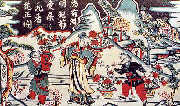 Chinese New Year, orSpring Festival, is the longest and most important holiday for Chinese people. It is usually celebrated from the eighth day of the twelfth month to the fifteenth of the first month (lantern festival), byChinese lunar calendar. Traditionally, from the 23rd to the 27th of the twelfth lunar month, every family cleans and paints their houses and does New Year shopping. In rural China, hanging New Year paintings is a must. Bought from the market,New Year picturesare hanged on every important spots of the house-the gete, rooms, the kitchen, the storehouse, the well, and the stable. Portraits of village god and kitchen got are usually pasted up on niched to express people's wishes for peace and happiness. For average Chinese farmers, hanging New Year paintings bring about unusual festive joy and delight to them.
Chinese New Year, orSpring Festival, is the longest and most important holiday for Chinese people. It is usually celebrated from the eighth day of the twelfth month to the fifteenth of the first month (lantern festival), byChinese lunar calendar. Traditionally, from the 23rd to the 27th of the twelfth lunar month, every family cleans and paints their houses and does New Year shopping. In rural China, hanging New Year paintings is a must. Bought from the market,New Year picturesare hanged on every important spots of the house-the gete, rooms, the kitchen, the storehouse, the well, and the stable. Portraits of village god and kitchen got are usually pasted up on niched to express people's wishes for peace and happiness. For average Chinese farmers, hanging New Year paintings bring about unusual festive joy and delight to them.
Many provinces in China are known for their distinctive New Year paintings, from northern Hebei, Shangdong, Henan andTianjin, to southern Shandong, Henan and Tianjin, to southern Guangdong and Fujian, from eastern Jiangsu to western Shaanxi and Sichuan. Among them, the painting genre from Wuqiang County, Hebei Province enjoys a long history, diversified styles and widespread reputation.
 Woodprint New Year painting from Wuqiang is noted as one of China's seven major New Year painting genres. The other six are from Taohuawu of Jiangsu,Yangliuqingof Tianjin, Mianzhu of Sichuan, Yangjiabu of Shandong, Zhuxianzhen of Henan andFoshanof Guangdong.
Woodprint New Year painting from Wuqiang is noted as one of China's seven major New Year painting genres. The other six are from Taohuawu of Jiangsu,Yangliuqingof Tianjin, Mianzhu of Sichuan, Yangjiabu of Shandong, Zhuxianzhen of Henan andFoshanof Guangdong.
First appearing in theHan Dynasty(206 BC-220 AD), Chinese New Year painting became widespread during the Tang (618-907 AD) and Song (960-1127) and enjoyed its heydays during the Ming (1368-1644) and Qing (1644-1911). Wuqiang New Year painting emerged 500 years ago. Folk artists first painted each picture and later block print was applied to the creation. During the period from 1662 to 1820, Wuqiang was one of the largest sources of woodprint New Year painting in the north. There were 144 shops in the town dealing with New Year painting and thousands of farmers in the surrounding 40 villages painting in their workshops. The largest four shops even set up some 160 outlets across the country, selling paintings to a dozen of provinces. The largest annual output of Wuqiang paintings reached some 100 million pieces, accounting for one third of the country's total.
